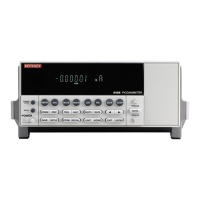I-16 Applications Guide Model 6485 Picoammeter Instruction Manual
Using protection circuitry
Using the protection circuitry described in Figure I-13 or on “Voltages greater than 220V,”
page 2-6 can greatly reduce currents and voltages presented to devices being tested, as
well as serving to protect the 6485 from any externally generated transients. The method
from Figure I-13 is preferred when measuring nonlinear devices such as transistors,
diodes, or photodiodes, as long as the accuracy required during normal measurements is
not tighter than 10pA. If using the scheme from “Voltages greater than 220V,” page 2-6,
size the external current limiting resistor such that the sum of the external resistor and the
lowest R
F
will limit a 10V transient to a current level acceptable to the DUT.
Reduce up-ranging transient
If the application requires that up-ranging be used, and when the transient through the
internal limiting resistor R
F
would damage the DUT, the up-ranging transient can be
reduced greatly by reducing the input current to <10% of the present range before forcing
the range change up (manual, or fixed-ranging over the bus). This can be true when run-
ning the first I-V curve on devices whose characteristics are not yet known, so that sweep-
ing from low current towards high current is the only way to avoid exceeding a maximum
current through the device.
Zero check on / off response
Figure I-13 shows the transient that can be expected from input HI to LO during a change
in the zero check mode with no input current. The transition is similar for entering and
leaving zero check. For current ranges 2µA and below, the magnitude of the response is
not as large, but similar in duration. As with range change transients, the zero check tran-
sient is presented through an internal impedance which will limit the resulting current
through the DUT (Table I-2). If there is an input current while in zero check, the input
voltage will depend on the current and the zero check input impedance for the specific
range.

